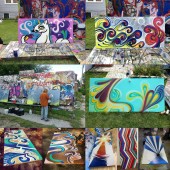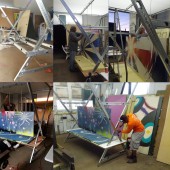DESIGN NAME:
Door Stops
PRIMARY FUNCTION:
Public seating
INSPIRATION:
Bus stops advertise the transit system to the public. A stop that looks dirty or neglected, or whose waiting passengers look hot, cold, wet, confused or vulnerable sends a devastating message - you’re lucky you don’t have to ride the bus. The use of public transportation is typically read as being without means - that the people, place and service of public transportation are at best, secondary considerations in the economic and environmental operations of the city. We wanted to change that.
UNIQUE PROPERTIES / PROJECT DESCRIPTION:
Door Stops is a collaboration between designers, artists, riders and community residents to fill neglected public spaces, like transit stops and vacant lots, with seating opportunities to make the city a more pleasant place to be. Designed to provide a safer and aesthetically pleasing alternative to that which currently exists, the units are infused with large displays of public art commissioned from local artists, making for an easily identifiable, safe and pleasant waiting area for riders.
OPERATION / FLOW / INTERACTION:
We have designed the structures to be mobile, to move from location to location as determined by riders and residents. Should there arise a need for seating at different locations due to change in service or traffic patterns, the seats can be relocated accordingly with little effort. In this, each piece can more quickly respond to the needs as determined by its residents than the bureaucracy of the city can allow.
PROJECT DURATION AND LOCATION:
Initial unit installed September 2013. 1st phase will continue until August 2014. Units to be located throughout the City of Detroit.
FITS BEST INTO CATEGORY:
Social Design
|
PRODUCTION / REALIZATION TECHNOLOGY:
Recycled and donated doors and studs from demolished, deconstructed or salvaged homes, reused translucent plastic signage panels, repurposed electrical conduit clamps, threaded rods, plywood and rubber casters
SPECIFICATIONS / TECHNICAL PROPERTIES:
width 2.5m x length 2.5m x height 2.5m
TAGS:
street furniture, mural art, transit seating, bus shelters, community design, public interest design, social justice, design activism, repurposed material art
RESEARCH ABSTRACT:
This project aims to bring the citizen back into a position of prominence in the decision- and place-making process with respect to the city’s collective spatial conditions by giving citizens the tools to make desires visible. A very small tool, yes, but one that addresses a number of immediate and long-term, tangible and intangible concerns. It begins small but has the ability to aggregate into a larger, cumulative impact.
CHALLENGE:
As functional architecture, these structures must offer tangible benefits to riders of weather protection, boarding identification and rest area. As pieces of art, they must offer constantly changing public art and opportunities for local artists to ply their trade and talents. Together, they have to provide an opportunity for riders and residents to create a space of their own making - a choice that will ultimately comment on the state of transportation and the quality of the public realm.
ADDED DATE:
2013-10-12 19:17:04
TEAM MEMBERS (23) :
Craig L. Wilkins, Damon Dickerson, Erik Howard, Chazz Miller, Jessica Harris, Mollie Decker, Rosa Mariá Zamarrón, Michael Sklenka, Gordon Soderberg, Molly Landis, Dennis Thom, Paul Mungar, Ryon P. Gonzalez, William Wey, Nicole Lapointe, Jessica Rowland, Bree Hietala, Kevin Boyd, Vanessa Cronan, Bradley Bailey, Young Detroit / The Alley Project Collaborative, The Detroit Mural Factory and and additional artists as the project expands
IMAGE CREDITS:
all images: Craig L. Wilkins, 2013
|










